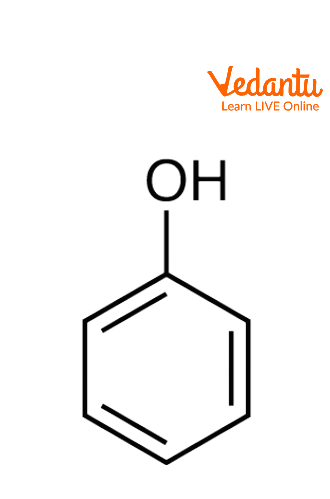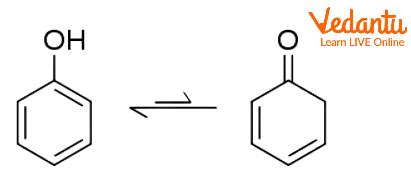




Any member of the family of organic compounds called phenols is distinguished by an attached hydroxyl (OH) group to a carbon atom of an aromatic ring. Monohydroxybenzene or phenol. The phenol formula is C6H5OH. Phenol is also known as benzenol or carbolic acid and it is the family's simplest member, and the term "phenol" serves as both the general name for the entire group and the specific name for it. While in this article we only discuss the phenol which has a benzene ring attached with a hydroxyl group.

Structure of Phenol
General Properties of Phenol
The molecular formula of phenol is C2H5OH and molecular mass 94.113 g mol-1
It is a transparent crystalline solid with a sweet and tarry odour.
The density is 1.07 grams per centimetre cube, melting point is 40.5 °C and boiling point is 181.7 °C
Approximately 84.2 g of phenol dissolve in 1000 mL of water, making it a notable organic chemical that is water soluble (0.895 M). Sodium phenoxide, the sodium salt of phenol, is significantly more water-soluble.
Nomenclature of Phenols
The term "phenol" refers to organic substances that have at least one -OH group directly linked to the benzene ring. Phenols are divided into three categories: monohydric, dihydric, and trihydric, depending on how many hydroxyl groups are linked to the benzene ring.
Monohydric Phenols - Hydroxybenzene, often known as phenol, is the most basic compound in this group, while the others are referred to as substituted phenols. The term "cresols" refers to the three isomeric hydroxyl toluenes.
Dihydric Phenols - Catechol, resorcinol, and quinol are the three isomeric dihydroxy benzenes and are more commonly referred to by these names.
Trihydric Phenols - These are also referred to as trihydroxy phenols. Trihydric phenols are also known by the names pyrogallol, hydroxyquinol, and phloroglucinol.
Natural Occurrence of Phenols
Phenols are very commonly present in nature. Tyrosine is one of the standard amino acids found in most proteins. Epinephrine (adrenaline), is a stimulant hormone produced by the adrenal medulla. The essential oils of plants are utilised as flavours and fragrances. For instance, the flavour vanillin is extracted from vanilla beans. All these are examples of phenols. From the distillation of coal tar or crude petroleum, phenol, cresols (methylphenols), and other simple alkylated phenols can be produced.
Acidity of Phenols

Resonance Structures of the Phenoxide Anion
Phenol is a weak acid. It is in equilibrium with the phenolate anion (also called phenoxide) C6H5O- in an aqueous solution in the pH range of approximately 8 to 12. Compared to aliphatic alcohols, phenol has a higher acidity. Resonance stabilisation of the phenoxide anion is thought to be the cause of the different pKa values. Through the pi system, the negative charge on oxygen is thereby delocalised onto the ortho and para carbon atoms.
Tautomerism in Phenols

Phenol-cyclohexadienone Tautomerism
With its unstable keto tautomer cyclohexadienone, phenol exhibits keto-enol tautomerism; nonetheless, very little phenol is found in the keto form. Only one in ten trillion molecules are now in the keto form due to the equilibrium constant for enolization being approximately 10-13. The small amount of stabilisation gained by swapping a C=C bond for a C=O bond is more than compensated by the significant destabilisation brought on by the loss of aromaticity. As a result, phenol only really exists as enol.
Preparation of Phenol
Cumene Process
This is also known as the Hock process where Cumene (isopropylbenzene) is partially oxidised to cumene hydroperoxide in presence of air. Cumene hydroperoxide when treated with a dilute acid produces phenol and acetone. this process also yields significant amounts of acetone, a reaction byproduct. By using this technique, pure phenol can be obtained.
From Benzene Sulphonic Acid
This is the first method used commercially to produce phenol. At 573 K, sodium benzene sulphonate and sodium hydroxide are fused to produce sodium phenoxide, which is then acidified to produce phenol.
From Diazonium Salts (Laboratory Method)
Phenol is produced when the diazonium salt solution is added to a boiling dilute sulphuric acid or when the diazonium salt solution is steam distilled.
Reactions of Phenol
A hydroxyl group is connected to an aromatic ring, which is highly ortho/para directing. Phenols have a high reactivity toward electrophilic aromatic substitution at their ortho and para carbons.
Aromatic ring reactions: Because of resonance, the hydroxyl group in phenol is ortho and para directing, increasing electron density at ortho and para positions. Thus, electrophilic substitution reactions occur in phenol.
Phenol Uses
Phenol is most frequently used to produce plastic precursors, accounting for two-thirds of its total production.
Phenol is also a useful precursor to a wide range of medications like aspirin, including several herbicides and pharmaceutical drugs.
In molecular biology, phenol is a component of the liquid-liquid phenol-chloroform extraction method used to extract nucleic acids from tissue or cell culture samples.
Many people use phenol as an antiseptic. Joseph Lister was the first to use it. For otology treatments, concentrated liquid phenol can be applied topically as a local anaesthetic.
Due to its low cost, phenol is used for numerous small-scale purposes. In order to remove epoxy, polyurethane, and other chemically resistant coatings, it is a component of industrial paint strippers used in the aviation sector.
The formulation of cosmetics has utilised phenol derivatives.
Toxicity of Phenols
Due to the protein-degenerating activity of the phenol, it has a corrosive effect on skin and mucosal membranes. Dermatitis or even second and third-degree burns may result from repeated or prolonged skin contact with phenol. Lung oedema could develop after inhaling phenol vapour. The phenol might affect the heart and central nervous system, causing dysrhythmia, seizures, and coma. The kidneys could also be impacted. The liver and kidneys may suffer negative consequences from prolonged or recurrent exposure to the drug.
Important Questions
Write a note on phenol solubility in water.
Ans: Approximately 84.2 g of the organic compound phenol can be dissolved in 1000 mL of water, making it a highly soluble substance (to form a 0.895 M solution). Phenol-to-water mass ratios of 2.6 and higher allow for homogenous phenol-water solutions. sodium phenoxide, the phenol sodium salt, is far more water soluble than phenol
Why is phenol considered to be an acid?
Ans: One may classify phenol as a weak acid. In aqueous solutions with a pH between 5 and 6, it is in equilibrium with the phenolate anion C6H5O-, commonly known as phenoxide. Since it contains an OH group and the aromatic ring resonance stabilises the phenoxide anion, phenol is more acidic than aliphatic compounds.
Summary
Phenol is an aromatic organic molecule having the chemical formula C6H5OH, also known as carbolic acid. It is a volatile white crystalline substance. A phenyl group and a hydroxyl group are joined to form the molecule. It is mildly acidic and should be handled carefully because it can result in chemical burns.
Originally extracted from coal tar, phenol is now produced in huge quantities (about 7 billion kg/year) from feedstocks supplied by petroleum. Due to its role as a precursor to numerous minerals and beneficial chemicals, it is a crucial industrial commodity. Plastics and related materials are largely created using it. The manufacture of polycarbonates, epoxies, Bakelite, nylon, detergents, herbicides like phenoxy herbicides, and several pharmaceutical medications all depend on phenol and its chemical derivatives.
Practice Questions
Which of these is not the name of phenol?
Carbolic acid
Hydroxybenzene
Phenic acid
Methylbenzene
Phenol is acidic due to the presence of which of these effects?
Resonance effect
Common ion effect
Steric effect
Solvation effect
Answers
(d)
(a)
FAQs on Phenol
1. What is the Nature of Phenol? Is it Acidic or Basic?
Phenols are slightly acidic. However, they are much more acidic than aliphatic organic compounds. The reason for the acidity of phenols is the phenol formula.
It consists of a phenyl ring with an attached hydroxyl group. The OH group makes it a monobasic acid. Also, the aromatic ring resonance stabilizes the phenoxide ion and helps in maintaining acidity of the solution. When in an aqueous solution of pH between 8 and 12, a phenol dissociates and forms phenolate anion which has the chemical formula C6H5O-. This ion is also known as phenoxide. The phenoxide ion provides acidic character to the solution.
2. What are Some of the Uses of Phenol?
Phenol has several uses. It first found application as a disinfectant in surgical procedures. It is also well known as an old soap. Its cleansing abilities were often in use in this industry. With time, it shifted to household detergents and disinfectants. Apart from that, it finds application in several small-scale industries. It is present in industrial paint, and it removes a lot of resistant coating such as epoxy and polyurethane from parts manufactured in the aviation industry. It is also a part of a lot of drugs. Phenols also find a place in the making of sunscreens, exfoliators and other cosmetic products.
3. What are electrophilic aromatic substitution reactions?
When an atom that is a part of an aromatic ring is replaced by an electrophile, the reaction is called an electrophilic aromatic substitution reaction. These reactions frequently entail the substitution of an electrophile for a hydrogen atom that is a part of a benzene ring. A process involving electrophilic aromatic substitution maintains the aromaticity of the aromatic system. The six fundamental electrophilic aromatic substitution processes are Friedel-Crafts acylation, alkylation, chlorination, nitration, and sulfonation. Each of these reactions needs an acid catalyst to be activated in order for the comparatively inert aromatic ring to attack it.
4. What are nucleophilic substitution reactions?
Nucleophilic substitution reaction is a class of organic reactions where one nucleophile replaces another. It is very similar to the normal displacement reactions which we see in chemistry, where a more reactive element replaces a less reactive element from its salt solution. The group which takes the electron pair and is displaced from the carbon is known as the “leaving group” and the molecule on which substitution takes place is known as the “substrate”. The leaving group leaves as a neutral molecule or anion.
5. Is phenol toxic to living beings?
Skin, eyes, nose, throat, and nervous system irritation may result from phenol exposure. Weakness, tiredness, muscle pains, and soreness are a few signs of phenol exposure. Skin burns, tremors, convulsions, and twitching are just a few of the side effects of severe exposure. Exposure to phenol may cause injury to workers. The degree of harm depends on the dosage, time, and amount of work being done. Phenol will quickly permeate the skin if left there, causing cell death and gangrene in the process. There is a danger of immediate mortality if more than 60 square inches of skin are damaged. Phenol can inflict significant harm before pain is noticed and appears to have local anaesthetic qualities.











